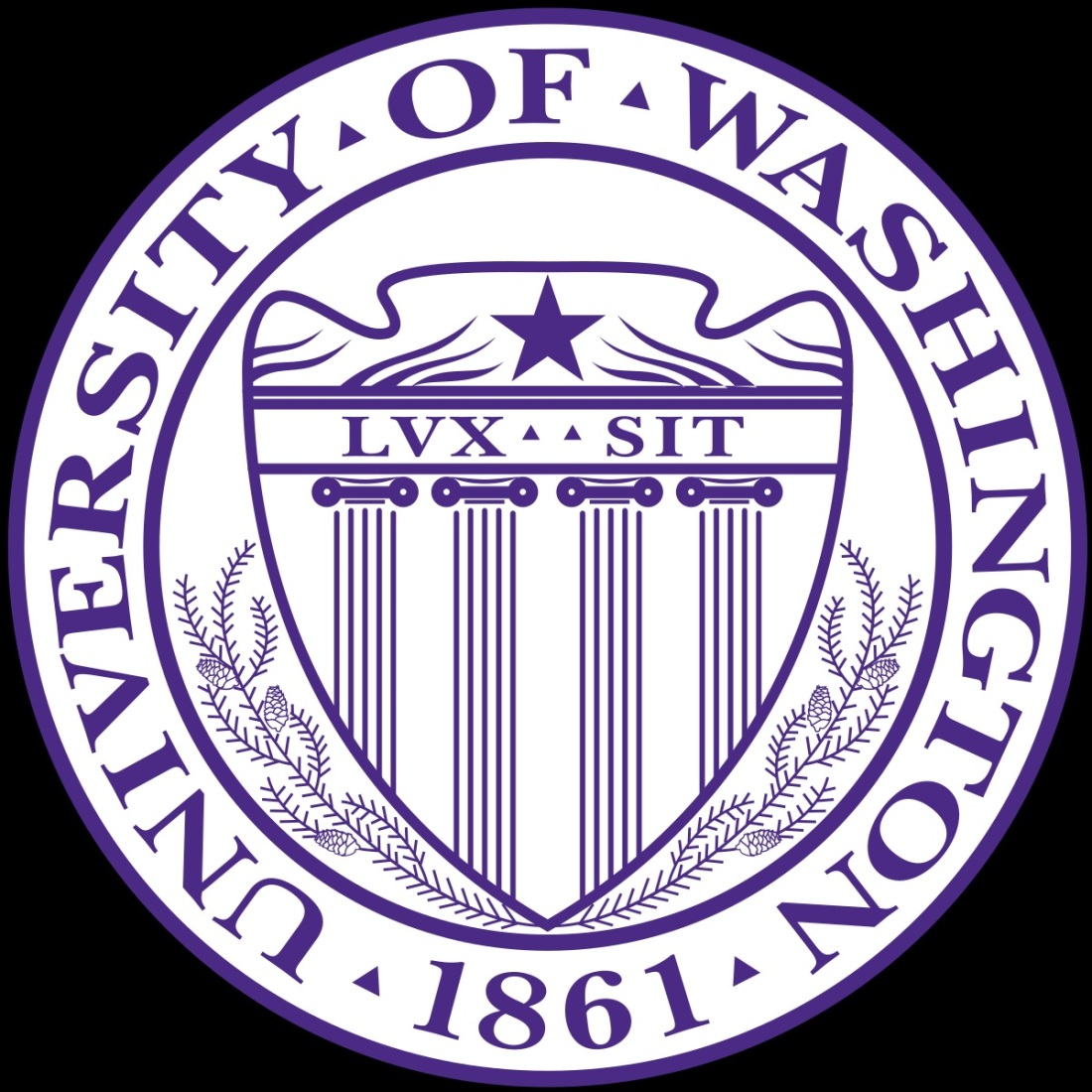From Civil & Environmental Engineering
In
At
From The University of Washington
3.26.24
Stacey Kendall
Photos by Alex Blair
At a UW lab, students are testing ways to give concrete a solid future.
Nestled in a former airplane hangar in the sprawling former Navy base at Magnuson Park, construction and engineering students from the University of Washington stress-test recipes for concrete—one of the world’s most used substances. Made with a combination of cement, water and aggregates, some type of concrete has been produced by every civilization since the Babylonians. Now, university students are joining in the centuries-long quest to refine and perfect this essential material at the University of Washington Center for Education and Research in Construction (CERC).
Dr. Fred Aguayo, who joined the faculty of the College of Built Environments in 2021, is the director of the Construction Methods and Concrete Materials Laboratory (which Aguayo has dubbed CM2L), as well as an assistant professor with the Department of Construction Management and an adjunct assistant professor with the Department of Civil and Environmental Engineering. You could say he enjoys watching cement “dry”—but of course he’s heard that one before. Since joining the UW, it’s his expertise in the field that has allowed more of a focus into concrete and its potential.
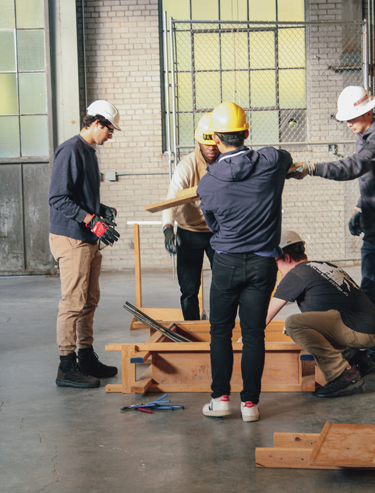
The goal of the UW Construction Methods and Concrete Materials Lab is to become a resource for the construction industry as a certified materials testing ground.
The lab, while surprisingly tidy for a place that sees concrete smashed daily, is very much a working environment—something that Aguayo takes pride in. “Don’t expect to wear a white coat,” he says, smiling wide. “Any student coming through here, whether doing research or course lab experiments, will benefit from working so hands-on going into the construction industry.” The construction materials lab also is a key resource for other UW units, such as architecture, civil and environmental engineering, and chemistry and materials science students. The lab is a place where project samples from these and other departments can be brought to be tested, and then scaled up to real proportions within the hangar’s lofty heights. From undergraduate to doctoral students, this cross-college collaboration is another thing Aguayo appreciates about the work done in the lab. As one of the state of Washington’s only academic experts actively researching concrete materials and their durability, Aguayo has a unique specialty that allows students to see and participate in the future of the concrete construction industry.
Research into cement-based systems of infrastructure is good news for the estimated 4.1 billion tons of cement produced globally, mostly in China. Potential innovations in material durability, alternative and supplementary cement binders, recycled aggregates and high-performing concrete are the keys to improving environmental sustainability, safety and longevity.
Sustainability, notes Aguayo, is one of the things he sees as foremost on the minds of the students who come through the lab. As the Pacific Northwest continues to lead the pursuit of more environmentally responsible materials and methods, innovations in this area cannot come soon enough. Burning limestone to obtain lime, one of the main components of ubiquitous Portland cement, creates CO2, and the cement-making process has been attributed as one of the leading causes of human-made CO2, often cited as around 9% of its global production. While extending the lifespan of the sturdy stuff is one of the main solutions to cutting down on production, as well as discovering more effective outcomes of recycling it, alternative and more environmentally friendly cements are a central focus of Aguayo’s research into the next generation of concrete materials.
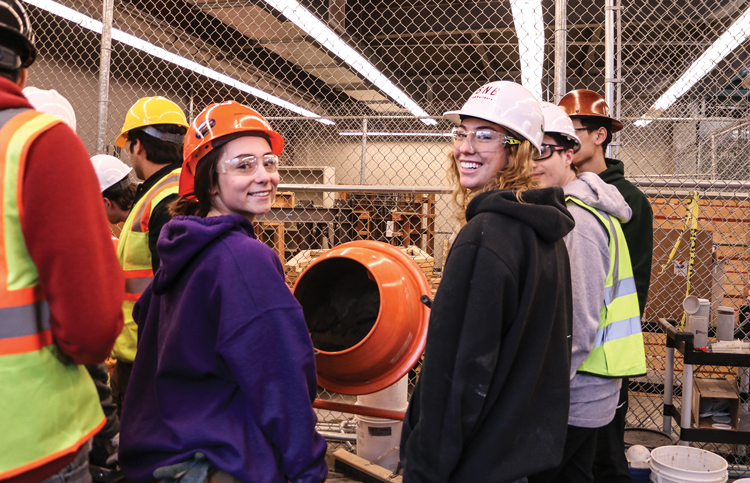
It’s a great thing that students are getting hands-on experience making construction materials. Approximately 11,000 lane miles of roads in Washington state require repair.
For example, using ground limestone to partially replace Portland cement can reduce its carbon footprint and be an effective strength-promoting filler. Known as Portland Limestone Cements, it is one of the current “hot” topics in the concrete industry, Aguayo says. An unintended (but positive) consequence of burning less coal than in previous decades is the reduced availability of coal fly ash, a byproduct of coal burning and one of the most used supplementary binders in making concrete. Completely alternative cementitious materials such as calcium sulfoaluminate (CSA) cement are beginning to gain attention for their remarkably fast strength-gaining properties, superior durability and lower CO2 footprint than ordinary Portland cement and other infrastructure materials. Imagine the difference in construction timelines with concrete that cures faster, is just as durable (or more durable) and more environmentally friendly. “CSAs can develop most of their design strength in as little as three to four hours, for what would normally take days or weeks in traditional Portland cement binder,” says Aguayo. It’s these types of alternative or supplemental binders that represent a big opportunity in cement and concrete research and would be game-changing for the construction industry.
And innovations in concrete could benefit repairs even more in new construction. Infrastructure such as roads, bridges, utilities and dams are among the enduring repair challenges for cities and states. Seattleites’ daily confrontations with potholes and corroded concrete should spotlight the understanding of the shortcomings of this material as we know it. According to the Washington State Department of Transportation, about 11,000 lane miles of roads in the Evergreen State require repair. Part of the 2022 “Move Ahead Washington” infrastructure package ($3 billion over 16 years) will address numerous repairs and expansions. Longer-lasting concrete could mean fewer maintenance crises.
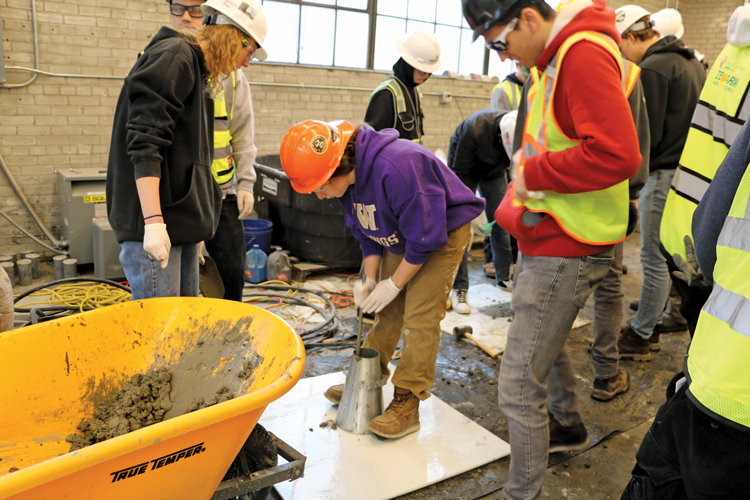
Students try out new recipes for making concrete, such as replacing Portland cement with ground limestone. HAT could yield a product with excellent strength and a reduced carbon footprint.
Meanwhile, the UW Construction Methods and Concrete Materials Lab continues to build on its importance. Giovanni Migliaccio, chair and professor of the Department of Construction Management and executive director of the UW Center for Educational Research in Construction, predicts that in six to eight years, the lab can serve the construction industry as a certified testing ground, supporting so many of the local companies that already lend their expertise to the students in the form of the department’s advisory council. “We have nearly 40 companies and associations that support our mission through mentoring, internships and scholarships. They also support when classes need a site visit, guest lecturer, coaches for a competition or occasional special needs like software and equipment,” Migliaccio explains. The mix of research and real-life industry involvement has immeasurably increased the department’s and college’s profiles, and it’s only growing. To wit, Migliaccio says their programs have seen a substantial increase in both master’s student applications and undergraduate interest, especially among high school graduates who apply to the UW and list the major as their first or second choice.
The playfulness of undergraduate experiments, Aguayo reveals, is the lighter side of working with this heavyweight substance. One student, he recalls, used broken glass from a bottle as the “rock” in a mix of white concrete to make some coasters and concrete countertops. Not as a strength experiment, but to make it look cool. And it worked. Perhaps the next college to get in on the lab’s creation capabilities will be art.
Whether churning out decorative or cutting-edge alternative concretes, the CERC continues to evolve and grow. UW concrete is making a great case for being the foundation of the future.
See the full article here .
Comments are invited and will be appreciated, especially if the reader finds any errors which I can correct.

five-ways-keep-your-child-safe-school-shootings
Please help promote STEM in your local schools.
Stem Education Coalition
The University of Washington Civil & Environmental Engineering
Take a moment to look around you. Buildings, bridges, running water and transit systems are the work of civil and environmental engineers.
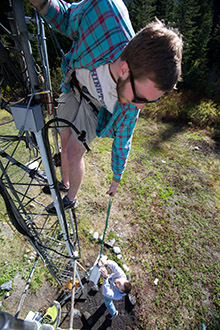
Civil and environmental engineers design, construct and manage the essential facilities, systems and structures around us. Their work plays a crucial role in enabling livable, sustainable cities, healthy environments and strong economies.
At the University of Washington, Civil & Environmental Engineering students and faculty are taking on the challenges presented by our aging national infrastructure, while developing new approaches to address the needs of urban systems and communities around the globe. UW CEE is dedicated to providing students with leading-edge technical skill development and opportunities for hands-on practice to enable them to tackle complex engineering problems in response to changing technological and societal needs.
Housed in an outstanding university, UW CEE offers one of the world’s premier programs in the field. The UW College of Engineering undergraduate program is ranked very highly and CEE’s graduate programs are ranked very highly for civil engineering and environmental engineering for according to U.S. News & World Report.
The University of Washington College of Engineering
Mission, Facts, and Stats
Our mission is to develop outstanding engineers and ideas that change the world.
Faculty:
275 faculty (25.2% women)
Achievements:
128 NSF Young Investigator/Early Career Awards since 1984
32 Sloan Foundation Research Awards
2 MacArthur Foundation Fellows (2007 and 2011)
A national leader in educating engineers, each year the College turns out new discoveries, inventions and top-flight graduates, all contributing to the strength of our economy and the vitality of our community.
Engineering innovation
Engineers drive the innovation economy and are vital to solving society’s most challenging problems. The College of Engineering is a key part of a world-class research university in a thriving hub of aerospace, biotechnology, global health and information technology innovation. Over 50% of UW startups came from the College of Engineering.
Commitment to diversity and access
The College of Engineering is committed to developing and supporting a diverse student body and faculty that reflect and elevate the populations we serve. We are a national leader in women in engineering; 25.5% of our faculty are women compared to 17.4% nationally. We offer a robust set of diversity programs for students and faculty.
The University of Washington is one of the world’s preeminent public universities. Our impact on individuals, on our region, and on the world is profound — whether we are launching young people into a boundless future or confronting the grand challenges of our time through undaunted research and scholarship. Ranked very highly in the world in Shanghai Jiao Tong University rankings and educating more than 54,000 students annually, our students and faculty work together to turn ideas into impact and in the process transform lives and our world. For more about our impact on the world, every day.
So, what defines us —the students, faculty and community members at the University of Washington? Above all, it’s our belief in possibility and our unshakable optimism. It’s a connection to others, both near and far. It’s a hunger that pushes us to tackle challenges and pursue progress. It’s the conviction that together we can create a world of good. Join us on the journey.
The University of Washington is a public research university in Seattle, Washington, United States. Founded in 1861, University of Washington is one of the oldest universities on the West Coast; it was established in downtown Seattle approximately a decade after the city’s founding to aid its economic development. Today, the university’s 703-acre main Seattle campus is in the University District above the Montlake Cut, within the urban Puget Sound region of the Pacific Northwest. The university has additional campuses in Tacoma and Bothell. Overall, University of Washington encompasses over 500 buildings and over 20 million gross square footage of space, including one of the largest library systems in the world with more than 26 university libraries, as well as the UW Tower, lecture halls, art centers, museums, laboratories, stadiums, and conference centers. The university offers bachelor’s, master’s, and doctoral degrees through 140 departments in various colleges and schools, sees a total student enrollment of over 46,000 annually, and functions on a quarter system.
University of Washington is a member of the Association of American Universities and is classified among “R1: Doctoral Universities – Very high research activity”. According to the National Science Foundation, UW spends billions on research and development, ranking it very highly in the nation. As the flagship institution of the six public universities in Washington state, it is known for its medical, engineering and scientific research as well as its highly competitive computer science and engineering programs. Additionally, University of Washington continues to benefit from its deep historic ties and major collaborations with numerous technology giants in the region, such as Amazon, Boeing, Nintendo, and particularly Microsoft. Paul G. Allen, Bill Gates and others spent significant time at Washington computer labs for a startup venture before founding Microsoft and other ventures. The University of Washington’s 22 varsity sports teams are also highly competitive, competing as the Huskies in the Pac-12 Conference of the NCAA Division I, representing the United States at the Olympic Games, and other major competitions.
The university has been affiliated with many notable alumni and faculty, including Nobel Prize laureates, Pulitzer Prize winners, Fulbright Scholars, Rhodes Scholars and Marshall Scholars.
In 1854, territorial governor Isaac Stevens recommended the establishment of a university in the Washington Territory. Prominent Seattle-area residents, including Methodist preacher Daniel Bagley, saw this as a chance to add to the city’s potential and prestige. Bagley learned of a law that allowed United States territories to sell land to raise money in support of public schools. At the time, Arthur A. Denny, one of the founders of Seattle and a member of the territorial legislature, aimed to increase the city’s importance by moving the territory’s capital from Olympia to Seattle. However, Bagley eventually convinced Denny that the establishment of a university would assist more in the development of Seattle’s economy. Two universities were initially chartered, but later the decision was repealed in favor of a single university in Lewis County provided that locally donated land was available. When no site emerged, Denny successfully petitioned the legislature to reconsider Seattle as a location in 1858.
In 1861, scouting began for an appropriate 10 acres (4 ha) site in Seattle to serve as a new university campus. Arthur and Mary Denny donated eight acres, while fellow pioneers Edward Lander, and Charlie and Mary Terry, donated two acres on Denny’s Knoll in downtown Seattle. More specifically, this tract was bounded by 4th Avenue to the west, 6th Avenue to the east, Union Street to the north, and Seneca Streets to the south.
John Pike, for whom Pike Street is named, was the university’s architect and builder. It was opened on November 4, 1861, as the Territorial University of Washington. The legislature passed articles incorporating the University, and establishing its Board of Regents in 1862. The school initially struggled, closing three times: in 1863 for low enrollment, and again in 1867 and 1876 due to funds shortage. University of Washington awarded its first graduate Clara Antoinette McCarty Wilt in 1876, with a bachelor’s degree in science.
19th century relocation
By the time Washington state entered the Union in 1889, both Seattle and the University had grown substantially. University of Washington’s total undergraduate enrollment increased from 30 to nearly 300 students, and the campus’s relative isolation in downtown Seattle faced encroaching development. A special legislative committee, headed by University of Washington graduate Edmond Meany, was created to find a new campus to better serve the growing student population and faculty. The committee eventually selected a site on the northeast of downtown Seattle called Union Bay, which was the land of the Duwamish, and the legislature appropriated funds for its purchase and construction. In 1895, the University relocated to the new campus by moving into the newly built Denny Hall. The University Regents tried and failed to sell the old campus, eventually settling with leasing the area. This would later become one of the University’s most valuable pieces of real estate in modern-day Seattle, generating millions in annual revenue with what is now called the Metropolitan Tract. The original Territorial University building was torn down in 1908, and its former site now houses the Fairmont Olympic Hotel.
The sole-surviving remnants of Washington’s first building are four 24-foot (7.3 m), white, hand-fluted cedar, Ionic columns. They were salvaged by Edmond S. Meany, one of the University’s first graduates and former head of its history department. Meany and his colleague, Dean Herbert T. Condon, dubbed the columns as “Loyalty,” “Industry,” “Faith”, and “Efficiency”, or “LIFE.” The columns now stand in the Sylvan Grove Theater.
20th century expansion
Organizers of the 1909 Alaska-Yukon-Pacific Exposition eyed the still largely undeveloped campus as a prime setting for their world’s fair. They came to an agreement with Washington’s Board of Regents that allowed them to use the campus grounds for the exposition, surrounding today’s Drumheller Fountain facing towards Mount Rainier. In exchange, organizers agreed Washington would take over the campus and its development after the fair’s conclusion. This arrangement led to a detailed site plan and several new buildings, prepared in part by John Charles Olmsted. The plan was later incorporated into the overall University of Washington campus master plan, permanently affecting the campus layout.
Both World Wars brought the military to campus, with certain facilities temporarily lent to the federal government. In spite of this, subsequent post-war periods were times of dramatic growth for the University. The period between the wars saw a significant expansion of the upper campus. Construction of the Liberal Arts Quadrangle, known to students as “The Quad,” began in 1916 and continued to 1939. The University’s architectural centerpiece, Suzzallo Library, was built in 1926 and expanded in 1935.
After World War II, further growth came with the G.I. Bill. Among the most important developments of this period was the opening of the School of Medicine in 1946, which is now consistently ranked as the top medical school in the United States. It would eventually lead to the University of Washington Medical Center, ranked by U.S. News and World Report as one of the top ten hospitals in the nation.
In 1942, all persons of Japanese ancestry in the Seattle area were forced into inland internment camps as part of Executive Order 9066 following the attack on Pearl Harbor. During this difficult time, university president Lee Paul Sieg took an active and sympathetic leadership role in advocating for and facilitating the transfer of Japanese American students to universities and colleges away from the Pacific Coast to help them avoid the mass incarceration. Nevertheless, many Japanese American students and “soon-to-be” graduates were unable to transfer successfully in the short time window or receive diplomas before being incarcerated. It was only many years later that they would be recognized for their accomplishments during the University of Washington’s Long Journey Home ceremonial event that was held in May 2008.
From 1958 to 1973, the University of Washington saw a tremendous growth in student enrollment, its faculties and operating budget, and also its prestige under the leadership of Charles Odegaard. University of Washington student enrollment had more than doubled to 34,000 as the baby boom generation came of age. However, this era was also marked by high levels of student activism, as was the case at many American universities. Much of the unrest focused around civil rights and opposition to the Vietnam War. In response to anti-Vietnam War protests by the late 1960s, the University Safety and Security Division became the University of Washington Police Department.
Odegaard instituted a vision of building a “community of scholars”, convincing the Washington State legislatures to increase investment in the University. Washington senators, such as Henry M. Jackson and Warren G. Magnuson, also used their political clout to gather research funds for the University of Washington. The results included an increase in the operating budget from $37 million in 1958 to over $400 million in 1973, solidifying University of Washington as a top recipient of federal research funds in the United States. The establishment of technology giants such as Microsoft, Boeing and Amazon in the local area also proved to be highly influential in the University of Washington’s fortunes, not only improving graduate prospects but also helping to attract millions of dollars in university and research funding through its distinguished faculty and extensive alumni network.
21st century
In 1990, the University of Washington opened its additional campuses in Bothell and Tacoma. Although originally intended for students who have already completed two years of higher education, both schools have since become four-year universities with the authority to grant degrees. The first freshman classes at these campuses started in fall 2006. Today both Bothell and Tacoma also offer a selection of master’s degree programs.
In 2012, the University began exploring plans and governmental approval to expand the main Seattle campus, including significant increases in student housing, teaching facilities for the growing student body and faculty, as well as expanded public transit options. The University of Washington light rail station was completed in March 2015, connecting Seattle’s Capitol Hill neighborhood to the University of Washington Husky Stadium within five minutes of rail travel time. It offers a previously unavailable option of transportation into and out of the campus, designed specifically to reduce dependence on private vehicles, bicycles and local King County buses.
University of Washington has been listed as a “Public Ivy” in Greene’s Guides since 2001, and is an elected member of the American Association of Universities. Among the faculty there have been many members of American Association for the Advancement of Science, the National Academy of Sciences, the American Academy of Arts and Sciences, the National Academy of Medicine, winners of the Presidential Early Career Award for Scientists and Engineers, members of the National Academy of Engineering, Howard Hughes Medical Institute Investigators, MacArthur Fellows, the Gairdner Foundation International Award, the National Medal of Science, Nobel Prize laureates, the Albert Lasker Award for Clinical Medical Research, members of the American Philosophical Society, winners of the National Book Award, winners of the National Medal of Arts, Pulitzer Prize winners, the Fields Medal, and the National Academy of Public Administration. There have been Fulbright Scholars, Rhodes Scholars, Marshall Scholars and Gates Cambridge Scholars. UW is recognized as a top producer of Fulbright Scholars.
The ARWU has consistently ranked University of Washington as one of the top 20 universities worldwide every year since its first release. The University of Washington is constantly ranked highly by the ARWU, the Times Higher Education World University Rankings, and in the Times World Reputation Rankings. Meanwhile, QS World University Rankings ranked it highly worldwide.
U.S. News & World Report ranks the University of Washington very highly out of nearly 1,500 universities worldwide, with University of Washington’s undergraduate program very highly among 389 national universities in the U.S.
The SCImago Institutions Rankings, and the Leiden Ranking, which focuses on science and the impact of scientific publications among the world’s 500 major universities, ranked University of Washington very highly globally and in the U.S.
Kiplinger Magazine’s review of “top college values” named University of Washington very highly for in-state students and very highly for out-of-state students among U.S. public colleges, and very highly overall out of 500 schools. In the Washington Monthly National University Rankings University of Washington was ranked very highly domestically, based on its contribution to the public good as measured by social mobility, research, and promoting public service.


